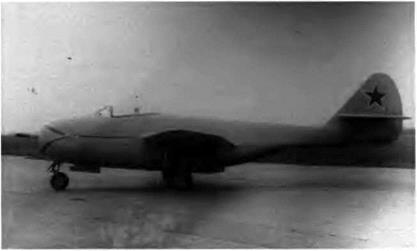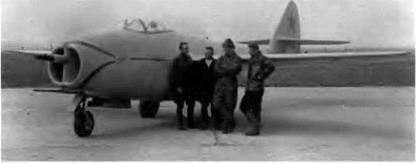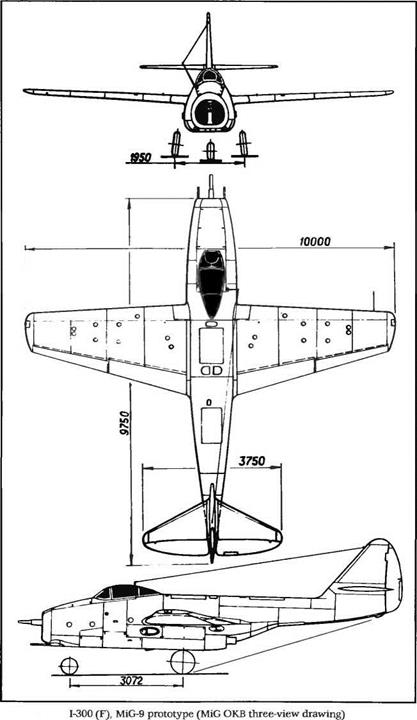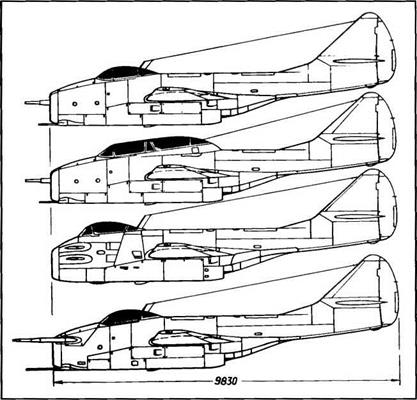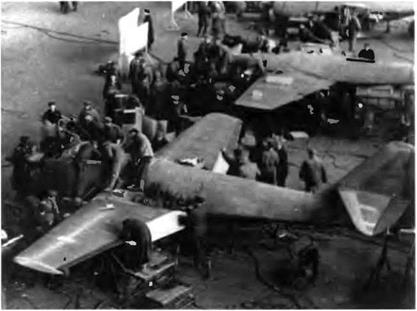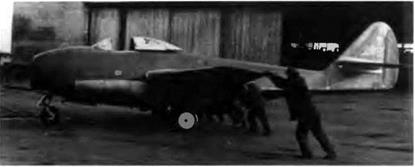MiG-Я Series
1-300 / r
At the end of World War II several OKBs —including MiG—were assigned to design fighters powered by a turbojet engine MiG had the advantage of experience with its 1-250 But above 900 km/h (486 kt) it
|
The 1-300 or izdeliye F, prototype of the MiG-9, was the first Soviet jet aircraft to fly— less than three hours before the Yak-15. |
was obvious that the technology of this aircraft’s combined power plant was completely outdated. And at that time there was not a single homemade jet engine available in the USSR, since all research programs in this field were postponed because of the war. The Soviets had to make do with the few jets recovered either in eastern Prussia or in Germany itself. Near the end of the war one of the factories that made BMW 003 and Junkers Jumo 004 jet engines fell into the hands of Soviet troops. It was then decided to mass-produce them in the USSR. After a close examination of each type the OKB engineers chose the BMW 003, which delivered 784 daN (800 kg st) and 1,568 daN (1,600 kg st) in a twin-jet configuration. A. G. Brunov was named the chief project engineer. In the first preliminary design the future F fighter had two underwing engines like the Messerschmitt Me-262, the Gloster Meteor, and the Sukhoi Su-9, which complied with the same specifications and was first flown in August 1946.
One of Mikoyan’s students, the well-known aeronautical expert A. V. Minayev, wrote in Aircraft of the USSR:
When Mikoyan started working on his fighter project, a lot of spadework had already been done as regards high-speed aerodynamics, aircraft aerodynamic configurations, and aeroelasticity. The more I go into this period, the more I am amazed at discovering the huge amount of R&D conducted during the war. No Soviet jet aircraft could have flown in 1946 without all this research work, which was all the more valuable to us because it was original and homemade.
|
Left to right, in front of the F-l, the first prototype of the 1-300: A. Karyev, test engineer; G. Buchtinov, trainee mechanic; A. Grinchik, test pilot (he was killed while flying the F-l), and V. Pimyenov, field mechanic. |
The preliminary designs for the project were highlighted by an innovative proposal made by Mikoyan: to place both jets side by side into the fuselage. With such an arrangement the wing remained aero – dynamically clean, drag was reduced, and maneuverability improved, particularly in the event of engine failure. The preliminary design was approved in the late fall of 1945. A full-scale mock-up was built, and manufacture of the parts and systems was launched. After approval of the mock-up in January 1946 the Narkomaviaprom issued decree no. 157, assigning to the MiG OKB the task of building and flight-testing the aircraft.
The 1-300, coded F at the OKB, was an all-metal midwing single- seater with a front air intake to feed the two jet engines. The two-spar straight wing had a TsAGI-1 series profile, a constant thickness ratio of 9 percent, slotted flaps, and Frise ailerons. The lower part of the rear fuselage was protected against the high-temperature exhaust gases by a heat shield (a 15-mm-thic. k air-gap sandwich of stainless steel plates with a corrugated core). The cantilever horizontal tail was set high on the fin to stay dear of the exhaust flow. Flying controls were standard; the stick rod-operated, the rudder pedals cable-operated. The cockpit was not pressurized.
The fuel system comprised four fuselage and six wing tanks having a total capacity of 1,635 1 (432 US gallons). The engines ran on T-2 kerosene—a fuel commonly used in tractor engines—because aviation kerosene was not yet available. Each BMW 003 was fitted with a Ridel
|
|
|
Top to bottom: 1-301 (FS), 1-301T (FT), МЮ-9М (FR), and 1-302 (FL) (MiG OKB drawing) |
combustion starter that ran on aviation gasoline. The armament of the prototype consisted of one 57-mm N-57 (100P) cannon in the air intake splitting wall and two 23-mm NS-23 (115Р) cannons with 80 rpg at the bottom of the air intake. This arrangement was to prove somewhat troublesome, as will be explained later. The N-57 was eventually replaced with a 37-mm N-37 with forty rounds.
For the first time, a Soviet fighter was fitted with a tricycle landing gear. The legs and wheels of the main gear retracted outward into wing wells. The castor front wheel retracted backward into the fuselage and was fitted with a hydraulic shimmy-damper. All of the landing gear had levered suspension with lower arms trailing the wheel.
On 6 March 1946 the prototype was rolled out and entrusted to the care of the factory flight-testing team. All systems were checked, the aircraft was weighed without and with fuel, and its engines were run up. No one actually knew the BMW 003’s time between overhauls, so a hypothetical ten-hour TBO was adopted. On 23 March the aircraft was
|
Extract from Flight Log No. 19, 24 April 1946
Source LII central archives. |
moved to the Ramenskoye airfield. Meanwhile, several airframes were stressed during static tests; they were progressively overloaded until they ruptured in order to determine their strength.
An experienced LII pilot, Aleksei Nikolayevich Grinchik (nicknamed Lesha), was put in charge of the flight tests of the 1-300 (F). In 1941-42 he flew sixty-two missions in a MiG-3 (later he flew an LaGG-3) and fought on the Kalinin front. He was wounded in the leg during a dogfight and forced to make a pancake landing. When he was released from the hospital he was appointed deputy director of flight tests at the LII. In the spring of 1946 there were no more than eleven first-class test pilots in the USSR; Grinchik was the youngest but probably the most experienced. Before the war he was a student at the Moscow Aviation Institute (MAI). When the war ended he joined the TsAGI to add to his knowledge. The flight-test team also included chief engineer A. Karyev and two field mechanics, V V. Pimyenov and G Bushtinov.
On 12 April 1946 Grinchik made the first ground rolls, and three days later he lifted it a few feet into the air. At more than 900 m (2,950 feet), the takeoff roll proved to be longer than expected. On 19 April the F climbed to 4 m (about 13 feet), and on 24 April it made its true first flight, which lasted twenty minutes. The first Soviet jet aircraft had flown. Three hours later the Yak-15 went up for its maiden flight.[1] The USSR’s jet era was under way.
The second flight took place on 7 May 1946, and the third flight on the eleventh. Not until the eighth flight was severe buffet noticed around the engines. The next three flights failed to identify their cause and eliminate them. On 5 June an emergency meeting was called in Mikoyan’s office to analyze the problem. After listening to the pilot and examining the flight-test data, well-known scientist M. V. Keldish proposed that the present layout of the aircraft be abandoned and the engines relocated either above or underneath the wings. He thought that the vibrations were caused by the stepping of the fuselage behind the engines. But during the twelfth flight on 7 July, after the heat shield was strengthened, the vibrations vanished inexplicably and test flights were finally resumed. Tragically, during the nineteenth flight four days later Grinchik was fatally wounded while giving a flight demonstration for a group of WS officers. The wing-to-body fairing broke off in flight, smashing the horizontal tail to pieces, and the aircraft crashed. This first 1-300, the F-l, had spent a total of six hours and twenty-three minutes in the air.
Two more prototypes, the F-2 and F-3, were assembled quickly in the experimental workshop The F-3 was flown for the first time by LII pilot M. L. Gallai on 9 August 1946, and the F-2 followed with G M. Shiyanov at the controls two days later. On 18 August Shiyanov led a flyover in this prototype during the air force day celebrations at Tushino.
By 28 October all of the following GK Nil WS pilots had flown the 1-300: A. G. Proshakov, A. M. Kripkov, A. G. Kubishkin, Yu. A. Antipov, and G A. Sedov (who is today chief constructor at the MiG OKB). The aircraft’s joint tests (factory tests plus state acceptance trials) got under way on 26 October, leading to certification During the state trials, over two hundred aerobatics were performed—including the first spin ever attempted by a jet aircraft—without a single engine failure. The certification document contained the following statement: "Its handling characteristics have made this aircraft, on the whole, easy and pleasant to fly. Its controls are not binding and it is not hard to get accustomed to this machine.” Mass production was consequently recommended and launched immediately. The aircraft entered service in the WS with the service designation of MiG-9.
Specifications
Span, 10 m (32 ft 9 7 in); length, 9.75 m (31 ft 11 8 in); height, 3.225 m (10 ft 6.7 in); wheel track, 1.95 m (6 ft 4.8 in); wheel base, 3.072 m (10 ft 0.9 in); wing area, 18 2 m2 (195 9 sq ft); empty weight, 3,283 kg (7,236 lb); takeoff weight, 4,860 kg (10,710 lb); fuel, 1,334 kg (2,940 lb); oil, 35 kg (77 lb); wing loading, 267 kg/m2 (54 .7 lb/sq ft); max operating limit load factor, 6.
Performance
Max speed, 910 km/h at 4,500 m (491 kt at 14,760 ft), max speed at sea level, 864 km/h (467 kt), climb to 5,000 m (16,400 ft) in 4.5 min; to 10,000 m (32,800 ft) in 14.3 min; service ceiling, 13,000 m (42,640 ft); landing speed, 170 km/h (92 kt); range, 800 km (497 mi); takeoff roll, 910 m (2,985 ft); landing roll, 735 m (2,410 ft); rate of turn, 9.73°/sec.
|
The first ten MiG-9s had to be delivered within seventy days; they were delivered in only fifty-five days This explains the feverish activity in this assembly shop. |
|
Rollout—by hand—of the premier MiG-9. The first ten aircraft were identical to the prototype. |











